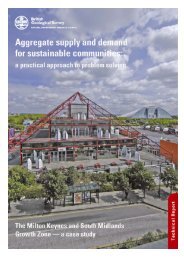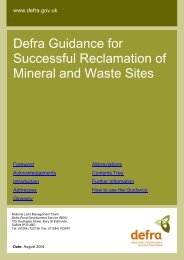creating environmental improvements through biodiversity
creating environmental improvements through biodiversity
creating environmental improvements through biodiversity
Create successful ePaper yourself
Turn your PDF publications into a flip-book with our unique Google optimized e-Paper software.
Output:<br />
Description of SEA, and differences between this and EIA<br />
Guidance, sources of information and references on SEA, case studies<br />
Biodiversity related:<br />
• Table of SEA topic coverage and baseline data sources. Included damage to internationally and nationally<br />
designated sites, and effects on regional BAP targets for habitats and species<br />
• Description of Environmental Capital Evaluation - summary of the Bovey Basin Ball Clay Strategy as<br />
example: Area was divided into character areas on basis of land use; <strong>environmental</strong> feature maps produced for<br />
each area; and services provided by each feature assessed (included different habitat types and <strong>biodiversity</strong>).<br />
Policy and management notes were produced for each site.<br />
• Assessment of usefulness of ‘Environmental and Quality of Life Capital’ approach to minerals planning<br />
– most useful at land allocation assessment stage or for Area Action Plans – data collection at detailed spatial<br />
level. Relatively untested at level of a Strategic Minerals Plan<br />
• Description of several other approaches such as ‘Sustainability Threshold Assessment’ and ‘Environmental<br />
Capacity’, where <strong>biodiversity</strong> is considered against other <strong>environmental</strong> factors. Different approaches evaluated<br />
• Description of Environmental Constraints Mapping, where nature conservation designations, landscape<br />
designations and ‘BAP areas’ are (and other constrains) are mapped against minerals resources. This is used to<br />
test whether sites in a development plan are developed in the least sensitive locations possible<br />
• Description of Site Assessments within SEA. These help to assess the ‘footprint’ of all (potential) minerals<br />
sites in one area, to determine the overall effects on local <strong>biodiversity</strong><br />
• Section on linking SEA to EIA<br />
• Discussion that SEA and minerals planning in the UK is at a very early stage. Techniques described are<br />
largely taken from other sectors / purposes. Highlights the need for MPAs to test which techniques are most /<br />
least feasible<br />
Sustainable Aggregates Creating Environmental Improvements <strong>through</strong> Biodiversity<br />
Impacts (Actual):<br />
The report describes different potential techniques for SEA, to be considered by the minerals industry.<br />
Biodiversity considerations are included. Biodiversity is considered alongside numerous other <strong>environmental</strong>,<br />
heritage and social factors.<br />
The report highlights a need for SEA training and awareness-raising on related issues among minerals planners.<br />
It also highlights the need for these techniques to be tested.<br />
Impacts (Potential):<br />
The report has potential to be widely considered by the minerals industry in the infancy of the SEA processes.<br />
We did not have information on how has this progressed since 2004.<br />
Dissemination:<br />
The report was publicised among all MPAs via a leaflet and free electronic document copies. The leaflet<br />
was also to be distributed at events organised by the Centre for Sustainability and the report publicised to<br />
delegates at the Sep 2003 SEA and minerals planning workshop. Other SEA workshops had been and would<br />
be held. It was also to be publicised on the Centre for Sustainability’s SEA Information website www.sea-info.<br />
net<br />
Articles were to be produced for publication in journals for <strong>environmental</strong> assessment and minerals planning<br />
audiences.<br />
The Centre for Sustainability was to investigate possible publication of the report on ODPM or DEFRA<br />
websites; setting up SEA subgroups within planning and <strong>environmental</strong> professional bodies; awareness raising<br />
events; training courses; and setting up regional SEA workshops.<br />
71

















